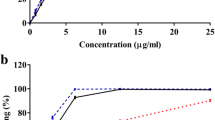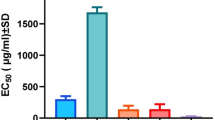Abstract
The antidiabetic effects of a hot water extract of the stems of Salacia chinensis (SCE) were evaluated in vivo in ob/ob mice (genetically obese hyperglycemic mice). Administration of dietary feed containing 0.20 and 0.50% of SCE for 23 days to ob/ob mice significantly suppressed the elevation of both blood glucose and HbA1c levels, without significantly changing body weight and food intake. To characterize the antidiabetic effects of the thiosugar sulfonium constituent neokotalanol (1), which has potent α-glucosidase inhibitory activity, we performed a similar in vivo study. HbA1c levels were significantly suppressed in ob/ob mice after the administration of dietary feed containing 0.0003% of neokotalanol (1) for 20 days. These results indicate that SCE and neokotalanol (1) are potential leads for the development of novel antidiabetic agents.


Similar content being viewed by others
References
Lindström P (2007) The physiology of obese-hyperglycemic mice [ob/ob mice]. Sci World J 7:666–685
Wang B, Chandrasekera PC, Pippin JJ (2014) Leptin- and leptin receptor-deficient rodent models: relevance for human type 2 diabetes. Curr Diab Rev 10:131–145
Betz B, Conway BR (2016) An update on the use of animal models in diabetic nephropathy research. Curr Diab Rep 16:18
Mayer J, Russel E, Bates MV, Dickie MM (1953) Metabolic, nutritional and endocrine studies of the hereditary obesity-diabetes syndrome of mice and mechanism of its development. Metabolism 2:9–21
Garthwaite TL, Martinson DR, Tseng LF, Hagen TC, Menahan LA (1980) A longitudinal hormonal profile of the genetically obese mice. Endocrinology 107:671–676
Xie J-T, Mehendale SR, Li X, Quigg R, Wang X, Wang C-Z, Wu JA, Aung HH, Rue PA, Bell GI, Yuan C-S (2005) Anti-diabetic effect of ginsenoside Re in ob/ob mice. Biochim Biophys Acta 1740:319–325
Lee Y-S, Cha B-Y, Saito K, Yamakawa H, Choi S-S, Yamaguchi K, Yonezawa T, Teruya T, Nagai K, Woo J-T (2010) Nobiletin improves hyperglycemia and insulin resistance in obese diabetic ob/ob mice. Biochem Pharmcol 79:1674–1683
Huang S-L, Yu R-T, Gong J, Feng Y, Dai Y-L, Hu F, Hu Y-H, Tao Y-D, Leng Y (2012) Arctigenin, a natural compound, activates AMP-activated protein kinase via inhibition of mitochondria complex I and ameliorates metabolic disorders in ob/ob mice. Diabetologia 55:1469–1481
Matsuda H, Yoshikawa M, Morikawa T, Tanabe G, Muraoka O (2005) Antidiabetogenic constituents from Salacia species. J Tradit Med 22(Suppl 1):145–153
Yoshikawa M, Morikawa T, Matsuda H, Tanabe G, Muraoka O (2002) Absolute stereostructure of potent α-glucosidase inhibitor, salacinol, with unique thiosugar sulfonium sulfate inner salt structure from Salacia reticulata. Bioorg Med Chem 10:1547–1554
Yoshikawa M, Pongpiriyadacha Y, Kishi A, Kageura T, Wang T, Morikawa T, Matsuda H (2003) Biological activities of Salacia chinensis originating in Thailand: the quality evaluation guided by α-glucosidase inhibitory activity. Yakugaku Zasshi 123:871–880
Morikawa T, Akaki J, Ninomiya K, Kinouchi E, Tanabe G, Pongpiriyadacha Y, Yoshikawa M, Muraoka O (2015) Salacinol and related analogs: new leads for type 2 diabetes therapeutic candidates from the Thai traditional natural medicine Salacia chinensis. Nutrients 7:1480–1493
Muraoka O, Morikawa T, Miyake S, Akaki J, Ninomiya K, Pongpiriyadacha Y, Yoshikawa M (2011) Quantitative analysis of neosalacinol and neokotalanol, another two potent α-glucosidase inhibitors from Salacia species, by LC–MS with ion pair chromatography. J Nat Med 65:142–148
Muraoka O, Xie W, Osaki S, Kagawa A, Tanabe G, Amer MFA, Minematsu T, Morikawa T, Yoshikawa M (2010) Characteristic alkaline catalyzed degradation of kotalanol, a potent α-glucosidase inhibitor isolated from Ayurvedic traditional medicine Salacia reticulata, leading to anhydroheptitols: another structural proof. Tetrahedron 66:3717–3722
Muraoka O, Morikawa T, Miyake S, Akaki J, Ninomiya K, Yoshikawa M (2010) Quantitative determination of potent α-glucosidase inhibitors, salacinol and kotalanol, in Salacia species using liquid chromatography-mass spectrometry. J Pharm Biomed Anal 52:770–773
Xie W, Tanabe G, Akaki J, Morikawa T, Ninomiya K, Minematsu T, Yoshikawa M, Wu X, Muraoka O (2011) Isolation, structure identification and SAR studies on thiosugar sulfonium salts, neosalaprinol and neoponkoranol, as potent α-glucosidase inhibitors. Bioorg Med Chem 19:2015–2022
Xie W, Tanabe G, Xu J, Wu X, Morikawa T, Yoshikawa M, Muraoka O (2013) Research progress of synthesis and structure-activity relationship studies on sulfonium-type α-glucosidase inhibitors isolated from Salacia genus plants. Mini Rev Org Chem 10:141–159
Akaki J, Morikawa T, Miyake S, Ninomiya K, Okada M, Tanabe G, Pongpiriyadacha Y, Yoshikawa M, Muraoka O (2014) Evaluation of Salacia species as anti-diabetic natural resources based on quantitative analysis of eight sulphonium constituents: a new class of α-glucosidase inhibitors. Phytochem Anal 25:544–550
Kobayashi M, Akaki J, Yamashita K, Morikawa T, Ninomiya K, Yoshikawa M, Muraoka O (2010) Suippressive effect of the tablet containing Salacia chinensis extract on postprandial blood glucose. Jpn Pharmacol Ther 38:545–550
Kobayashi M, Akaki J, Yamaguchi Y, Yamasaki H, Morikawa T, Ninomiya K, Yoshikawa M, Muraoka O (2016) Safety evaluation of long term and excess intake of the tablet containing hot water extract of Salacia hinensis. Jpn Pharmacol Ther 44:399–408
Yamada K, Sato-Mito N, Nagata J, Umegak K (2008) Health claim evidence requirements in Japan. J Nutr 138:1192S–1198S
Tsutani K, Takuma H (2008) Regulatory sciences in herbal medicines and dietary supplements. Yakugaku Zasshi 128:867–880
Nagata J, Yamada K (2008) Foods with health claims in Japan. Food Sci Technol Res 14:519–524
Shimizu M (2012) Functional food in Japan: current status and future of gut-modulating food. J Food Drug Anal 20(Suppl 1):213–216
Kashiwagi A, Kasuga M, Araki E, Oka Y, Hanafusa T, Ito H, Tominaga M, Oikawa S, Noda M, Kawamura T, Sanke T, Namba M, Hashiramoto M, Sasahara T, Nishio Y, Kuwa K, Ueki K, Takei I, Umemoto M, Murakami M, Yamakado M, Yatomi Y, Ohashi H (2012) Committee on the standardization of diebetes mellitus-related laboratory testing of Japan Diabetes Society. International clinical harmonization of glycated hemoglobin in Japan: from Japan diabetes society to national glycohemoglobin standardization program values. J Diabetes Investig 3:39–40
Acknowledgements
This work was supported by MEXT-Supported Program for the Strategic Research Foundation at Private Universities, 2014–2018, S1411037 (T.M.); and a Grant-in-aid for Scientific Research (KAKENHI), 18K06739 (K.N.), 16K08313 (O.M.), and 18K06726 (T.M.).
Author information
Authors and Affiliations
Corresponding authors
Ethics declarations
Conflict of interest
MK., J.A., Y.Y., and H.Y. are employees of Kobayashi Pharmaceutical Co. Ltd. K.N., Y.P., M.Y., O.M., and T.M. have no conflict of interest.
Additional information
Publisher's Note
Springer Nature remains neutral with regard to jurisdictional claims in published maps and institutional affiliations.
Electronic supplementary material
Below is the link to the electronic supplementary material.
Rights and permissions
About this article
Cite this article
Kobayashi, M., Akaki, J., Yamaguchi, Y. et al. Salacia chinensis stem extract and its thiosugar sulfonium constituent, neokotalanol, improves HbA1c levels in ob/ob mice. J Nat Med 73, 584–588 (2019). https://doi.org/10.1007/s11418-019-01311-w
Received:
Accepted:
Published:
Issue Date:
DOI: https://doi.org/10.1007/s11418-019-01311-w




